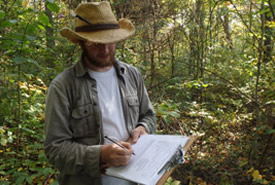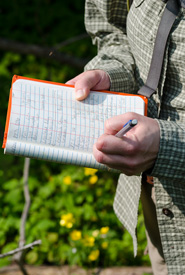Field journals in conservation 101

NCC reptile and amphibian technician, Louis Gagnon, records data during field variations of species at risk habitat models (Photo by NCC)
What are field guides?
Field journals or pages are used to take notes about a specific species, habitat or environment while in the field. These notes are used as a documentation for scientists to reference when evaluating an area of conservation. They may include details about a species, measurements of an area or even traces of an animal, such as footprints.
Field journals allow scientists (or citizen scientists) to record important data about an area or species to refer to outside of the field. These notes can also serve as a record of what type of species occurred in the area at the time of documentation. Scientist may also use field notes to describe the condition of a certain area. These observations can help decide appropriate methods to help conserve an area and the species that reside there.

NCC's Julie Vasseur records tree species in a quadrant of Holman's Island, PEI. (Photo by Sean Landsman)
What information is included in a field journal?
The details recorded in field notes often depend on what information a scientist is looking for. For example, a scientist may be in search of a particular species and only record these findings. Typically a general field journal will include:
- location
- date
- time
- temperature
- weather
- species name
- known status
- any applicable measurements (length, height, weight)
- sample, sketch or photo of the species
How do NCC staff use field journals?
Field journals, or similar documentation, are used by Nature Conservancy of Canada field staff to record details about species on our properties. This may include notes about an endangered plant species spotted while in the field; information that can alter the way an area is conserved. Field journals are also used when collecting population surveys on our properties.
Other resources used in the field
Field guides or books, published by scientists for scientists, are commonly used to help identify species in the field. They include detailed information and diagrams on how to correctly identify a species and information on where a species will reside. This helps scientists narrow down species based on geographical area, features and habitat.



